
Date: July 12, 2021
Location: Lat: 35.177792°, Lon: -48.116706°
Dive depth range: 1,192 - 1,366 meters (3,911 - 4,482 feet)
Access Dive Summary and ROV Data
This deep-sea nemertean worm was seen during Dive 09 of the 2021 North Atlantic Stepping Stones expedition. Belonging to the phylum Nemertea, these worms are also known as ribbon worms or proboscis worms. The latter name comes from their impressively long proboscis that they use for hunting. The proboscis is typically inverted into the body — in this video, you can see through the tissue some coils, which is the inverted proboscis. These worms also have the ability to produce a slippery mucus to help them navigate across the seafloor... and also makes them more difficult to catch! Video courtesy of NOAA Ocean Exploration, 2021 North Atlantic Stepping Stones: New England and Corner Rise Seamounts. Download largest version (mp4, 54.5 MB).
This eelpout in the ray-finned fish family Zoarcidae was spotted slowly swimming through the water column just above the seafloor at a depth of approximately 1,350 meters (4,430 feet) during exploration of Yakutat Seamount on Dive 09 of the 2021 North Atlantic Stepping Stones expedition. Video courtesy of NOAA Ocean Exploration, 2021 North Atlantic Stepping Stones: New England and Corner Rise Seamounts. Download largest version (mp4, 48.6 MB).
Dive 09 of the 2021 North Atlantic Stepping Stones expedition was the first of two expedition dives on Yakutat Seamount, this one being the shallower of the two.
The remotely operated vehicle landed on coarse sediments near the base of a near-vertical face of an elongated carbonate platform feature at the summit of the southwestern arm of the seamount. At the base of the wall as well as at its summit, we observed ancient coral rubble, undercut carbonate outcrops, and erratic dropstones. The steep wall of the platform was largely continuous and smooth with some wavy texture, which may be the result of a paleo reef that experienced wave action that took place when this seamount was in shallower water.
Overall density of life was lower on this dive than what we have observed during previous dives, though a good representation of species was noted. We saw a range of corals and sponges as well as urchins, sea stars, a few anemones and polychaete worms, and a larger number of fish than seen on previous dives.
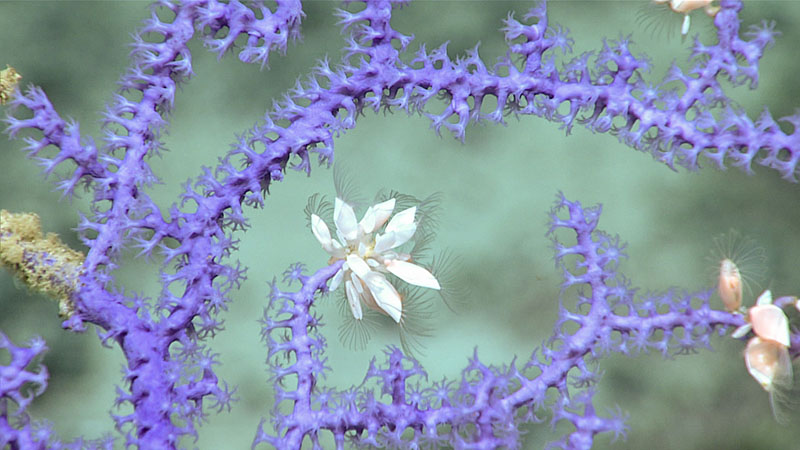
This unusual purple octocoral in the family Plexauridae was observed at a depth of 1,368 meters (4,488 feet) during Dive 09 of the 2021 North Atlantic Stepping Stones expedition. During the dive, we also saw at least five species of black corals, a bamboo coral in the genus Acanella, and two other species of octocoral. Image courtesy of NOAA Ocean Exploration, 2021 North Atlantic Stepping Stones: New England and Corner Rise Seamounts. Download largest version (jpg, 1.6 MB).
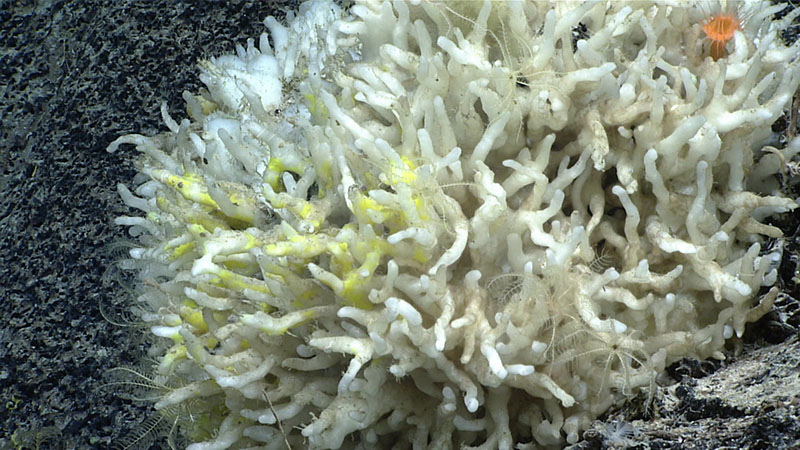
Throughout the ninth dive of the 2021 North Atlantic Stepping Stones expedition, we saw this unknown “finger sponge” in high-density patches. The white sponge was often covered in a yellow encrusting sponge. A small sample of the sponge was collected during the dive so that it can be analyzed to learn more about it and what it might be. Image courtesy of NOAA Ocean Exploration, 2021 North Atlantic Stepping Stones: New England and Corner Rise Seamounts. Download largest version (jpg, 1.2 MB).
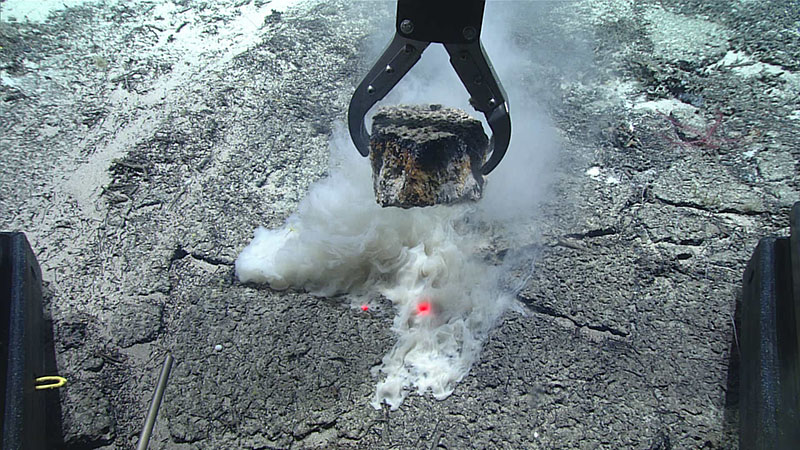
An impressively thick sample of in-place carbonate rock was collected during Dive 09 of the 2021 North Atlantic Stepping Stones expedition (note the two red dots, which are lasers spaced 10 centimeters (4 inches) apart). The collected sample revealed a thin ferromanganese coating at the surface of the rock, iron staining near the water-rock interface, and white carbonate at the bottom. The small, smoke-like plume seen in the image was created when the finer carbonate sediment on the seafloor was distrubed as the rock was removed. Image courtesy of NOAA Ocean Exploration, 2021 North Atlantic Stepping Stones: New England and Corner Rise Seamounts. Download largest version (jpg, 1.6 MB).
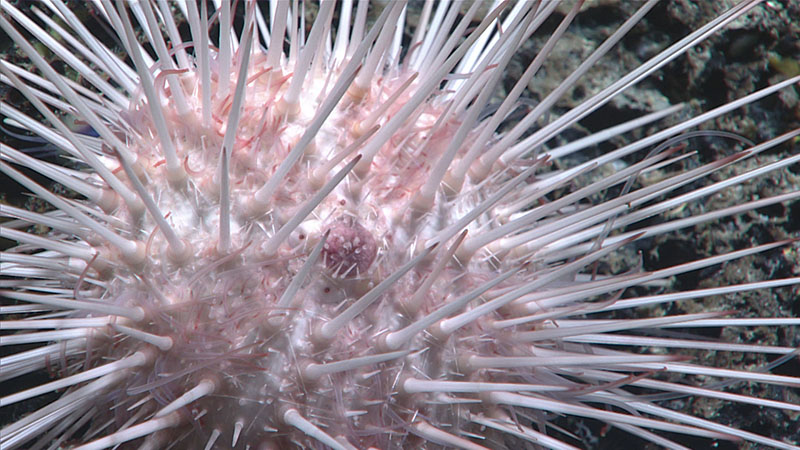
A close look at the spiky spines of an urchin of the genus Pentametrocrinus, seen during the ninth dive of the 2021 North Atlantic Stepping Stones expedition at a depth of 1,254 meters (4,115). We saw several echinothurid and cidarid pencil urchins during the dive. Image courtesy of NOAA Ocean Exploration, 2021 North Atlantic Stepping Stones: New England and Corner Rise Seamounts. Download largest version (jpg, 1.1 MB).
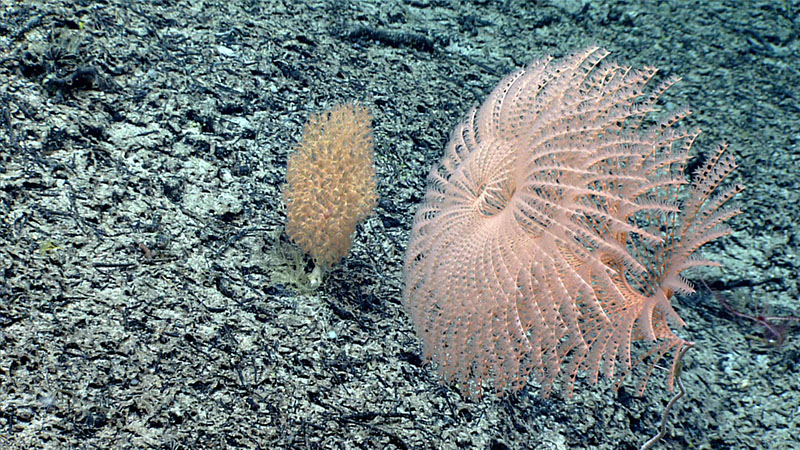
A spiraled Irridiogorgia fontanalis coral, only the second of this species ever observed, alongside an Acanella arbuscula bamboo coral, seen at the upper summit of a carbonate platform explored near the end of Dive 09 of the 2021 North Atlantic Stepping Stones expedition. Image courtesy of NOAA Ocean Exploration, 2021 North Atlantic Stepping Stones: New England and Corner Rise Seamounts. Download largest version (jpg, 1.8 MB).
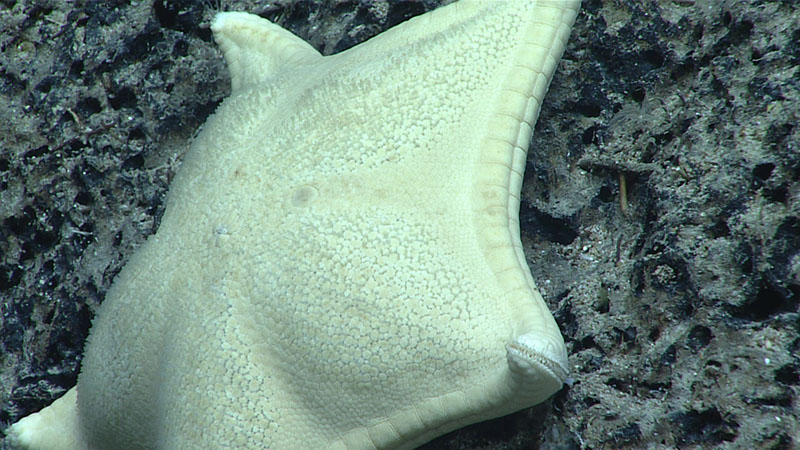
This hefty goniasterid sea star measured over 10 centimeters (4 inches) across. It was one of several sea stars seen during Dive 09 of the 2021 North Atlantic Stepping Stones expedition. During the dive, we also collected an unusual cushion star whose identification is unknown. Image courtesy of NOAA Ocean Exploration, 2021 North Atlantic Stepping Stones: New England and Corner Rise Seamounts. Download largest version (jpg, 1.3 MB).
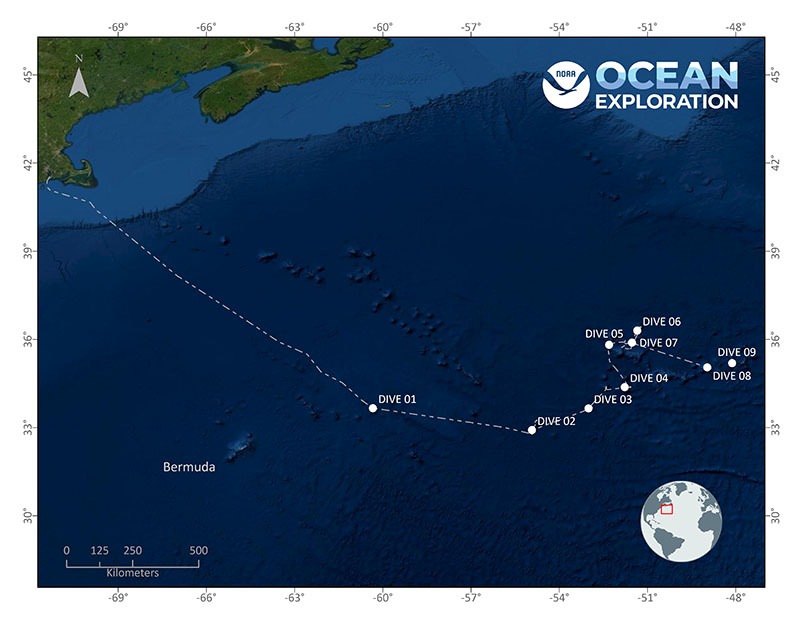
Location of Dive 09 of the 2021 North Atlantic Stepping Stones expedition on July 12, 2021. Map courtesy of NOAA Ocean Exploration, 2021 North Atlantic Stepping Stones: New England and Corner Rise Seamounts. Download largest version (jpg, 3 MB).
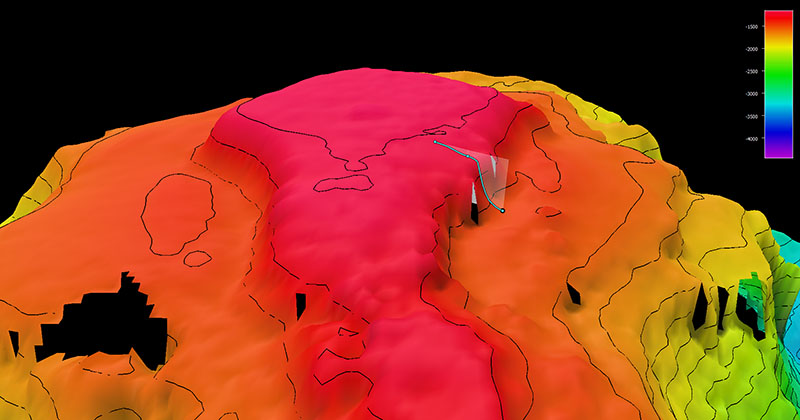
Image showing the dive track of Dive 09 of the 2021 North Atlantic Stepping Stones expedition. Scale is water depth in meters. Image courtesy of NOAA Ocean Exploration, 2021 North Atlantic Stepping Stones: New England and Corner Rise Seamounts. Download largest version (jpg, 674 KB).